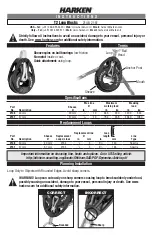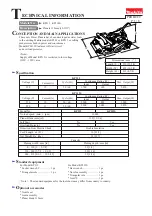
Installation and Operational Instructions for EAS
®
-compact
®
Ratchetting clutch, Type 49_._ _0._
Sizes 01 to 3
Synchronous clutch, Type 49_._ _5._
Sizes 01 to 3
(B.4.14.EN)
17/03/2021 TK/NU/GC/GF/SU
Chr. Mayr GmbH + Co. KG
Eichenstraße 1, D-87665 Mauerstetten, Germany
Phone: +49 8341 804-0, Fax: +49 8341 804-421
Page 16 of 22
The following applies to standard adjusting nut:
Even if the customer does not intend to change
the pre-set torque, the hexagon head screw
(10) must still be screwed out customer-side,
painted with Loctite 243 and screwed back in
again.
It is possible to check the
"Spring operation in the operating
range"
(Fig. 9) using the dimension "a" (distance from the
adjusting nut (5) facing side to the thrust washer (3) facing side,
as shown in Fig. 11).
Please see Table 3 for the respective values.
Turning the adjusting nut (5) clockwise causes
a reduction in torque.
Turning it anti-clockwise causes an increase in
torque.
You should be facing the adjusting nut (5) as
shown in Fig. 10.
Adjusting the torque for standard adjusting nut
a) Please convert the required torque using the formula below
into percent of the maximum adjustment value (see Table 3).
Required torque adjustment
x 100 = Adjustment in %
max. adjustment value
b) Loosen the hexagon head screw (10) in the adjusting nut (5).
c) Turn the adjusting nut (5) using the engraved adjustment
scale (Fig. 10) clockwise or anti-clockwise using a hook or a
face wrench until the required torque is reached.
d) The required torque results from the marking overlap (D) on
the locking ring (4) and the percent value (C) on the
adjusting nut (5), see Fig. 10.
e) Paint the hexagon head screw (10) with Loctite 243 and
screw it into the adjusting nut (5); the 4 notches (A) in the
adjusting nut (5) and the notches (B) in the locking ring (4)
must be in the same position (Fig. 9). Correct slightly if
necessary.
Fig. 10
Fig. 11
9
5
C
10
B
A
D
4
a
5
3
Face
wrench







































